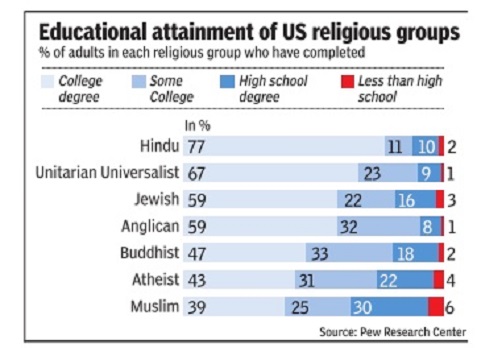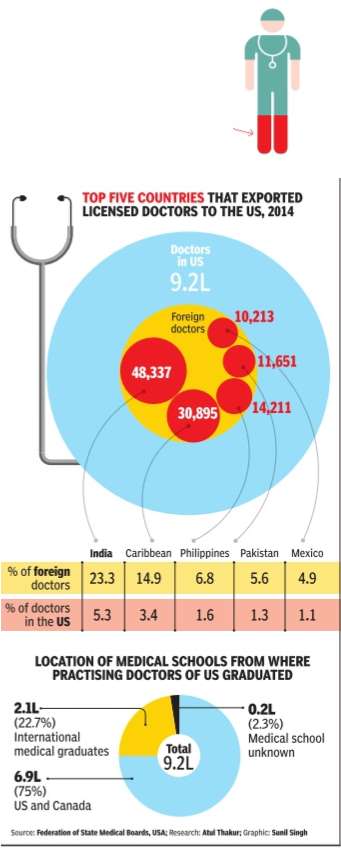Indians in the USA
This is a collection of articles archived for the excellence of their content. Readers will be able to edit existing articles and post new articles directly |
Economic status
The Times of India, Nov 10 2015
Chidanand Rajghatta
In 9 US states, Indians biggest immigrant bloc
For the longest time, Red states and Blue states in America have typically referred to Republican and Democratic leaning states in political and electoral terms. But in the world of immigration and demographics, it turns out they illustrate dominant Hispanic (mostly Mexican) and Asian (mostly Indian) populations. Amid reports that indicate India and China are now starting to send more legal immigrants to the United States than Mexico, new data from the US department of homeland security shows that Asian Indians form the biggest group of naturalized Americans in nine states, mostly in eastern US.
Mexican-Americans still dominate the central and western half of the US, but the fact Indians have such a high concentration in so many states comes as much as a surprise as Chinese not being the top immigrant population even in a single state.
Overall, Mexicans remain the single largest group of foreigners who were naturalized as citizens between 2003 and 2013, the decade for which DHS has released annualized data. But by state, Mexicans are the biggest group in only 24. Among the remaining 26 states plus the District of Columbia, 10 other nationalities claim the top spot, as this map shows.
In nine states, Indians make up the biggest group of naturalized citizens. Those from the Dominican Republic, who nationwide topped those from China for the first time in at least a decade, are the biggest group in five states, the DHS data shows.
Each year, roughly betwe en 800,000 to a million immigrants become naturalized US citizens. By country , the biggest groups after Mexico are India, Philippines, Dominican Republic and China. In recent years, more and more Indians are taking up US citizenship. DHS data from 20032013 shows Indians taking up US citizenship growing from about 30,000 annually to more than 60,000 annually towards the end of the decade, accounting for some 500,000 Indians who became American citizens in those 10 years.
Although they are outnumbered in California by Mexicans taking up US citizenship, the Golden State still remains their #1 destination.But in nine other states, including New Jersey , New York, Ohio, and Maryland, Indian-Americans top Mexicans-Americans numerically in terms of taking up citizenship.
The DHS data also shows that more than 50% of the emigrating Indians are in prime earning age of 25-44, suggesting that the US is benefiting from giving citizenship to productive immigrants. Retirees and homemakers formed less than 10% of Indians who got citizenship in 2013. Some 35% of Indian immigrants who took US citizenship worked in management, professional, service, production and sales occupations.
A community of professionals
Indians in US vital for transformation: Nancy Powell
TNN Aug 9, 2013
CHENNAI: Despite constituting less than 1% of the US population, Indian-Americans form 3% of the country's engineers, 7% of IT workers and 8% of physicians and surgeons, US ambassador Nancy J Powell said on Thursday while describing the community as "critical in shaping bilateral ties".
She recalled the visit of Martin Luther King Junior to the Presidency College (Madras) where he addressed a public gathering in 1959. "Both Vivekananda and King awakened the national consciousness of the United States against discrimination on the basis of colour, race, ethnicity and gender," she said.
2015: Median household income for Indian-Americans: highest for any ethnic groups
The Times of India, May 02 2015
Chidanand Rajghatta

PIOs in US race past $100k mark
Indian-Americans have long been recognized by US agencies and socio-political cognoscenti as America's best-educated and wealthiest ethnic group. But a snapshot released by the US Census Bureau this week reveals that the median household income for Indian-Americans has crossed the $100,000 per annum milestone, the highest for any ethnic group, including white, native-born Americans.
In fact, the groundbreaking figure was crossed almost two years ago in 2013 but came to light when the US Census Bureau put it out as part of the AsianPacific American Heritage month which is celebrated in May.
According to the Bureau, the median income of households headed by the Asian population in 2013 was $72,472, much higher than the national median income of around $51,000. But even among Asian Americans, Indian Americans racked it up at $100,547, almost double the national median income, and significantly more than even white, non-Hispanic Americans whose median income is approximately $57,000. Indian-Americans also outearned other South Asian groups such as PakistaniAmericans ($63,000) and Ban gladeshi-Americans ($51,000).Previously, the Census Bureau's American Community Survey in 2010 had put the Indian-American median family income at $86,135.
In contrast to the highearning groups, the median income of Black-American households was $33,321 and that of Hispanic households was $39,005.
Though the census report did not address the religious angle, other surveys have long indicated that Jewish-Americans come closest to IndianAmericans in terms of income and education. According to a US Religious Landscape Study by Pew Forum on Religion & Public Life in 2008, 46% of Jews reported family incomes of over $100,000 compared to 19% of all Americans, with the next highest group being Hindus at 43%. And while 27% of Americans have had college or postgraduate education, 59% of American Jews have it, the second highest of any religious group after American Hindus.
Hindus top education and income charts
In US, Hindus top education and income charts, Nov 05 2016 : The Times of India
Hindus are shining in the US this Diwali season with recent surveys showing they are the most highly educated religious group in the country , and also a close second in terms of household income.
Some 77% of America's Hindus have a college degree -a good 10 percentage point lead over the next group, the Unitarian Universalists. Jews are a distant third with 59%, shows data from a Pew Research Centre study published on Friday .
Showing a strong correlation between education and in come, Hindus also make the second place in America in terms of household income.While 44% of Jews earn $100,000 or more per annum, 36% of Hindus are in the same income bracket. But taking mid and high incomes together (above $50,000 per annum), Hindus inch ahead with a total of 70% of their population, as against 68% for Jews.
Last year, Hindus became the fourth largest religious group in the US with a population of 2.1million, amounting to 0.7% of the country's population.
Indian women earn more than white men, less than Asian men
The Times of India Jan 08 2016
Washington
Indian-American women earn more on average when compared to nonHispanic white men in the US, according to a new report.
However, compared to Asian-American men, AsianAmerican women only make 78 cents on the dollar, which is the largest gender gap among the racial and ethnic categories studied, the report by US Bureau of Labour Statistics (BLS) said. The smallest gender gap was among AfricanAmericans -black women earn nearly 90 cents on the dollar compared to black men.
Education has a lot to do with the Asian-woman advantage. More than half of AsianAmericans over 25 have a bachelor's degree or higher, compared to only 33% of non-Hispanic whites.
About 72% of Indian-Americans have four-year college degrees, and a 40% have some professional or graduate degree. This means that IndianAmericans are more likely to have advanced degrees than white Americans are likely to have finished college, the `Washington Post' reported.
About 21.8% of Asian-Americans also have graduate or professional degrees, compared to 12.8% of non-Hispanic whites. This could explain the advantage that Asian-women have over men, the report said.
Economist Mark Perry wrote in his blog that Asian women working full-time earned only about 3% less per week ($841) than the average full-time male worker ($871) in 2014, according to the latest Bureau of Labor Statistics data. Asian women working full-time in 2014 earned more per week on average than black ($680) and Hispanic men ($616).
Doctors of Indian (and Pakistani) origin
The Times of India Jan 09 2016
A majority of foreign doctors licensed to practise in the US are Indians who graduated from Indian medical schools. They constitute 23% of active foreign-educated physicians stthere.
lle of Notably, Osmania Medical College Hyderabad, with 2,118 doctors, ranranks 9th among the top 10 foreign medical cal schools whose graduates have active licences in the US
2016: co-found 14/ 87 billion $ startups
June 7, 2018: The Times of India

From: June 7, 2018: The Times of India
See graphic:
Billion dollar startups co-founded in the USA by immigrants from India, China and other countries
Immigrant entrepreneurs play a crucial role in the US startup scene. As of Jan 2016, 44 of 87 startups valued at more than $1 billion (unicorns) were co-founded by immigrants, creating an average of 760 jobs per company.
2016: Indians 2nd biggest group to get citizenship
December 1, 2017: The Times of India
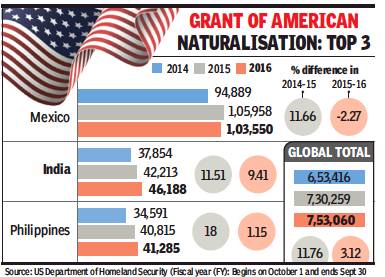
From: December 1, 2017: The Times of India
Nearly 46,100 odd Indians obtained US citizenship during 2016, making them the second largest group, even as Mexicans continued to top the chart. Indians accounted for 6% of the total citizenship conferredby the US government on 7.53 lakh individuals during the fiscal year 2016 (period between October 1, 2015 up to September 30, 2016), according to recent data released by the US department of homeland security (DHS).
A slight year-on-year decline in the number of citizenships being granted is visible, with immigration from Mexico showing a negative growth. The year-on-year increase in citizenship for Indians in 2016 was 9.4% against11.5% in 2015. Immigration experts say that those aspiring tobecome US citizens are nowfinding ittougher. There is an extreme vetting of applications and an uptake in denials on ‘odd’ grounds that date back many years. At the same time, uncertainty on work visa policies has spurred a significant spike in the number of applications. This has resulted in a huge processing backlog in administrative offices acrosstheUS.
The DHS has given aggregate data of the number of applications received over the years (a break-up based on country of origin isn’t available). With 9.72 lakh applications for citizenship (or naturalisation as it is referred to), the fiscal year 2016 saw a rise of 24% over the previous year. Comparatively, the 7.83 lakh applications in 2015 was just 1% higher than that in 2014.
Normally, only green card holders can opt for the naturalisation process. While a green card is a permit to live and work long-term in the US, the flux in visa policies and the focus on more jobs for citizens is inducing many green card holders to opt for US citizenship. “Indians, similar to other immigrants, now more than ever recognisethe valueof citizenship. A citizen has certain rights and protections — a fundamental right being that to vote. They also have additional job opportunities. Given the anti-immigrant rhetoric, immigrants are more aware of their needtobe protectedtothe full extent possible,” explains John C Yang, president and executive director of the nonprofit organisation Asian Americans Advancing Justice.
A report released in October by the National Partnership for New Americans (NPNA) states: The backlog of pending applications has increased by 77% over the past two years. At the end of June 2017, there were 7.08 lakh citizenship applicants waiting to be processed, up from 4 lakh applications at the same time two years earlier. The end resultis a waiting time of over a year, in many US states, to be sworn in as a US citizen, whereas two years ago, it averaged around 6 months. California, New York, Florida, and New Jersey, which are among the states with the highest backlog, have a significant number of Indians.
For many Indians, more than thedelay, itisthedenial of naturalisation that is worrying, as in some cases it can also adversely impact the existing green card status. “We also have concerns that applications have been unnecessarily subjected to inappropriate requests for follow-up information or investigations. Often, these involve family relationships or prior associations with employers or organisations that stretch years back. Some of these questions have gone back further in time than what we have seen before,” addsYang.
2017: Indians remain the richest
See graphic:
The median income of Chinese, Indians, Pakistanis and Sri Lankans in the USA in 2017; Biggest Asian groups in the USA; Biggest group of illegal immigrants from Asia in the USA

Biggest Asian groups in the USA;
Biggest group of illegal immigrants from Asia in the USA
From: September 17, 2017: The Times of India
2017: PIOs get key congressional panels
Desi lawmakers get key congressional panels, Jan 17, 2017: The Times of India
All five IndianAmerican lawmakers, the highest in the history of US congress, have been nominated to key congressional panels.
Ro Khanna, representing Silicon Valley , has been nominated to the House budget committee, while Pramila Jayapal, elected to the House of Representatives from Seattle, will serve on the House judiciary committee. Jayapal will also serve as a senior whip for the House Democrats and as vice chair for the Congressional Progressive caucus, where she will fight for solutions like a $15 per hour national minimum wage, comprehensive immigration reform, debtfree college, criminal justice reform, protecting women's reproductive rights and gun violence reform.
Raja Krishnamoorthi, representing Chicago, will serve on the House education and workforce committee. He said that his assignments would focus on job creation and affordable higher education.
Three-term Congressman Ami Bera has been renominated to the foreign affairs committee and science, space and technology committee. Bera is also co-chair of Congressional Caucus on India and Indian Americans. Kamala Harris, first Indian-American to have been elected to US Senate, has been made member of four powerful Senate committees -committee on budget, select committee on intelligence, committee on environment and public works and committee on homeland security and governmental affairs.
“These committees will be key battlegrounds in fight for the future of US. At a time when so many Californians and Americans are uncertain about our future, I will fight for our families and the ideals of our nation,“ Harris said.
2017: 40% decline in Indians looking for work in US
Oct 18, 2017:The Times of India
HIGHLIGHTS
There has been a 38% drop in Indians looking to move to the US.
Brexit may have led to 42% drop in Indians looking to move to UK.
Overall, there has been a 5% decrease in Indians looking to move abroad in search of job opportunities.
US president Donald Trump's anti-immigration stance and Britain's exit from the European Union last year have resulted in a lower number of Indians looking for jobs in these countries.
There has been a 38% and 42% drop in Indians looking to move to the US+ and UK respectively in the last one year (September 2016 to October 2017), compared to the corresponding previous year, data from job site Indeed showed. Overall, there has been a 5% decrease in Indians looking to move abroad in search of job opportunities, the report added.
The volatile political situations in developed countries have also made Indians look for jobs in their home country. The reverse job search to India has seen an uptick, with a 25% rise in people from the UK, the report said. The trend was even more pronounced for the Asia-Pacific region, with a 170% increase in interest in moving to India.
"This new data shows a reversal of the usual job search trend. The steadily growing Indian economy and political uncertainty abroad has per suaded skilled Indian talent to stay at home to find jobs and this in turn has fostered a thriving startup scene," said Sashi Kumar, managing director at Indeed India.
The report also showed that the prospect of Brexit could be deterring Indian job seekers looking to work in the UK+ . This has made them scout for other European countries such as Germany and Ireland, which has seen a 10% and 20% rise respectively from Indians in the same period, the report stated.
There has also been a 21% drop in the number of Indians looking to move to the Gulf because of the slump in oil price and economic slowdown in West Asia.
However, these same countries still figure among the top destinations for employees seeking job opportunities abroad. Despite the declining figures, the US still tops the list of countries that Indians would like to migrate to, with 49% of Indians searching for jobs overseas looking at the US. The other countries where Indians look to work include UAE (16%), Canada (9%), Great Britain (5%), Singapore(4%), Australia (3%), Qatar (2%), South Africa (1%) and Bahrain (1%).
Green cards
2018: 75% of applicants for green cards are Indians
Over 75% of those waiting for green cards are Indians, June 8, 2018: The Times of India

From: Over 75% of those waiting for green cards are Indians, June 8, 2018: The Times of India
Indians account for more than three-fourths of those highly skilled professionals waiting in queue to obtain legal permanent residence status in the US, popularly known as green card, according to the latest official figures.
As of May 2018, there were 395,025 foreign nationals waiting for green cards under the employment-based preference category. Of these, 306,601 were Indians, according to the latest figures released by US Citizenship and Immigration Services. This does not include counts of dependent beneficiaries associated with the approved immigrant petitions, it said. Under the existing law, no more than 7% of green cards may be issued to natives of any one independent country in a fiscal year.
Indian-Americans, most of whom are highly skilled and come to the US mainly on H-1B work visas, are the worst sufferers due to the per country quota. The current wait period for Indians for green card can be as long as 70 years.
According to a newly launched group, GCReforms.org, skilled immigrants from India need to wait anywhere between 25 and 92 years for a green card.
Illegal immigrants from India to the USA
See graphic:
Illegal immigrants in the USA, from India, Brazil, China and other countries, 2009-14
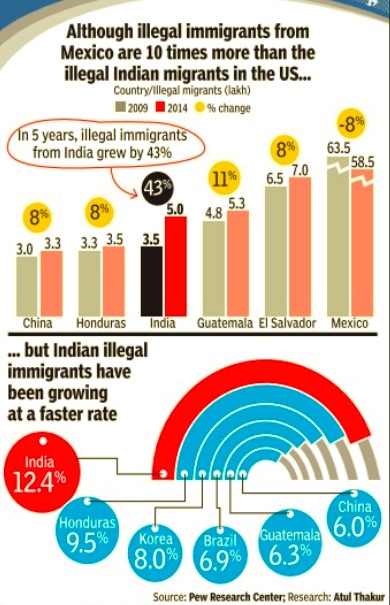
Nov 02 2016: The Times of India
National Geographic Bee
PIOs dominate, 2010, 2012-16
The Times of India, May 27 2016
PIOs sweep National Geographic Bee contest
Rishi Nair, 12year-old Indian-American student, has won the $50,000 National Geographic Bee competition in which Indianorigin contestants maintained their dominance by sweeping all the top three slots. Seven of the 10 finalists were Indian-Americans.
As National Geographic Bee champion in the 28th edition of the contest, Nair, a sixth grader from Florida, received a $50,000 college scholarship and a lifetime membership in the National Geographic Society. This is the fifth consecutive year that an Indian-American has won the prestigious national tournament. In 2015, Karan Menon had won the competition.
Eighth-grader Saketh Jonnalagadda, 14, from Massachusetts was the runner up and recipient of the $25,000 college scholarship. Third place and a $10,000 college scholarship was grabbed by Kapil Nathan, 12, a sixth-grader from Alabama. The final question, which clinched the win for Nair, was: “A new marine sanctuary will protect sharks and other wildlife around Isla Wolf in which archipelago in the Pacific Ocean?“.
The answer was: “Galapagos Islands“. Nair, whose parents hail from Kerala, is the second Florida student to win the contest. In 2010, eighthgrader Aadith Moorthy of Palm Harbor was the national champion. The contest ended with a nail-biting final round between Nair and Saketh.
The number of Indians in the USA
2008-2017: dwindling annual migration

From: Rachel Chitra and Ranjani Ayyar, Tightening US citizenship regime hits ‘American dream’ of desis, March 27, 2018: The Times of India
Indians will need more patience if they want to achieve the grand “American dream” — as data shows the US government is not granting citizenships at the pace it was doing a decade ago. In the last 30 years, the US was at its most liberal in 2008, when it granted as many as 65,971 citizenships; a reflection of the influx of Indian highly skilled immigrant workers arriving on US shores at the rate of 120,000 workers a year between 1995-2000.
While 2017 citizenship numbers (49,601) are an improvement from 2014 when it hit a decade-low (37,854) — the overall trend is still dampening as the number of immigrants have dropped to 1.51 million from 1.72 million during the same period. “The H-1B matter was a wake up call. Now companies are adopting a cautious approach given the changing policies. US companies do not require Indian techies as much as they needed earlier,” said Paul Dupius, CEO, Randstad India, a HR and staffing firm.
Since the 1990s Indians have been the second or third largest immigrant population to be granted citizenship after Chinese and Mexicans. Most Indians take the highly skilled work visa-green cardcitizenship route. But with immigration numbers on a decline the need for a fresh influx of Indian engineers, MBAs and doctors is waning as more US corporates looking to hiring locals.
“More Indians started coming to the use, when US immigration policy started favouring skill-based immigration to one based on family-connections. The average time it takes to process a green card has gone up from a couple of years to as much as 7-8. Indians have made more applications than any other country in the world – which means they have a longer waiting period,” said Mark Davies, an immigration lawyer.
Given that the biggest gateway to entering the US has been IT companies, the Trump administration’s recent policies are pushing US corporates to scale back recruitment of foreign workers.
Sikhs
Sikh family in US gets death threat
[ From the archives of the Times of India] circa 2008
A Sikh family in America received an anonymous letter that threatens to kill its members for being “associates of the Taliban”, prompting authorities to launch a probe into it.
The letter, addressed to the ‘Turban Family’, said the family is being closely watched and it should leave the US immediately. “Our people in the neighborhood have been closely watching your activities and figured out you are a close associate of a secret Taliban movement on the US Soil. We ask you to leave the country as soon as possible otherwise one of our people is going to shoot you dead. Don’t attempt to relocate elsewhere in America as people are closely monitoring your day to day activities,” the letter said. The identity of the family, which lives near Virginia, has not been released. Local authorities are working with the FBI to investigate the threats in the letter sent to the family last week.
The Sikh American Legal Defence and Education Fund said the family had previously been the target of similar hate crimes. PTI
Students (from India) in the USA
See Indian students in the USA
Top Indian-Americans
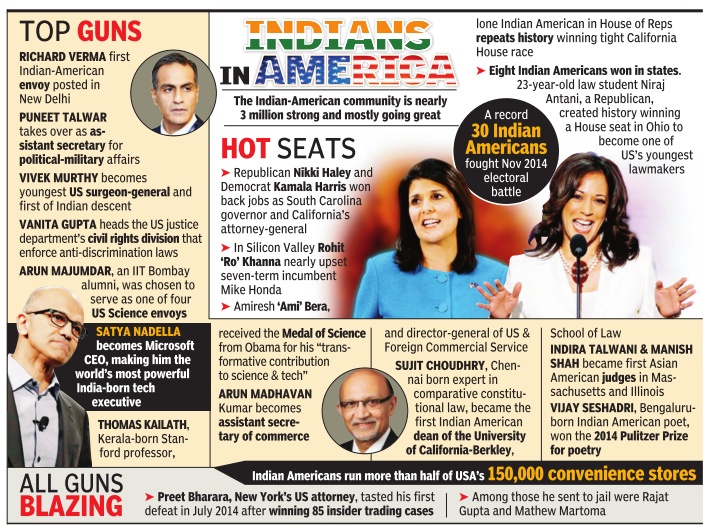
See graphic
Visa issues
’Overstayal’ by Indians
2014: 14,000 Indians overstay
The Times of India, Jan 22 2016
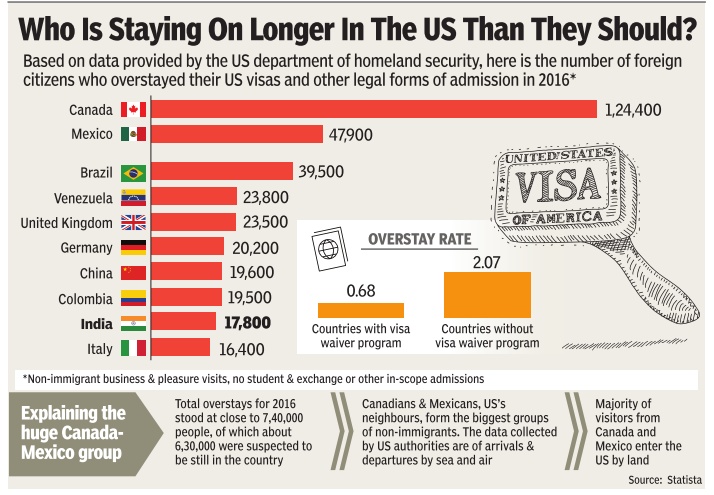
Over 14,000 of the 8.8 lakh Indians on business or tourism visas overstayed in the US last year, according to official figures.
And in 2014, of the 7.6 lakh Indians who were supposed to leave the country before the expiry of their B1B2 visas, 11,653 of them overstayed in the Unites States, the department of homeland security (DHS) said. Overstaying means a non-immigrant who was lawfully admitted to the US for an authorised period but stayed or remains in the country beyond his or her lawful admission period.
According to the `Entry Exit Overstay Report' released by the DHS, in fiscal 2015, of the nearly 45 million nonimmigrant visitor admissions through air or sea ports of entry that were expected to de part in FY 2015, 527,127 individuals overstayed their admission, for a total overstay rate of 1.17%. In other words, 98.83% had left the US on time and abided by the terms of their admission, the report said.
The report does not include students on F-1 visa or those who arrived on work visas like H1B. In FY 2015, of the nearly 45 million nonimmigrant visitor admissions that were expected to depart, DHS determined that 527,127 individuals overstayed their admission, for a total overstay rate of 1.17%. In other words, 98.83% had left the US on time and abided by the terms of their admission. In its report, DHS said several countries with ties to terrorism had significant numbers of nationals still in the US accounted for by the federal government.
2016: 30,000 Indians overstayed
30k Indians overstayed in US last year: Report, May 23, 2017: The Times of India
About 1.4 million Indians travelled to the US on various visas in 2016, out of which over 30,000 overstayed in the country , according to an annual official report.
The department of homeland security submitted the report to the Congress on foreign travellers who entered the US on various visas, including business, tourists, students and visitors exchange, as non-immigrant visitors. As per the report, more than 50 million nonimmigrants were expected to depart from the US in 2016. Of these, 739,478 overstayed their admission, resulting in a total overstay rate of 1.47%.
Of the more than 739,000 overstays, DHS said 628,799 were suspected “in-country“ overstays, meaning there is no record of these foreign nationals leaving the US.
Of these 30,000 Indians who overstayed, a little over 6,000 Indian nationals left the US after the expiry of their visas, the report said. In 2016, more than one million Indians who came to the US on business, tourist or pleasure were expected to leave the country. Of these 17,763 have overstayed in the country , it said.Among the overstayed are 2,040 Indians who departed the US only after the expiry of their visas.
Similarly, as many as 9,897 Indian students or exchange scholars were expected to depart by the end of the year and of which, 4,575 overstayed their legal period.
2016-17: 74% H-1B visa seekers are Indians
At 74%, Indians top H-1B visa seekers, Chinese distant 2nd, August 20, 2017: The Times of India

2.4L Indians Have Filed Applications Till June 30
With 2.47 lakh applications, Indians continued to be the largest group of H-1B visa aspirants during the first nine months of the current US financial year. The number works out to 74% of the total applications between October 1, 2016, and June 30, 2017. The US financial year begins from October 1 and ends on September 30. During 2015-2016 financial year, Indians had filed 3 lakh applications.
Though the number of Chinese H-1B aspirants is much lower by comparison, their visa applications till June 30 stands at 36,362 -their highest-ever over the past 10 financial years. A total of 35,720 applications were filed by the Chinese during 2015-16. Canada came third with 3,551 applications till June 30,2017.
The US received 3.36 lakh applications for H-1B visas till June 30, of which 1.97 lakh have been approved. The US Citizenship and Immigration Ser vices, which released this data, said many applications were still pending approval.
While a breakup of the applications approved based on the country of birth is not available till June 30, 2017, the USCIS report for 2015-16 shows that of 3.45 lakh approved applications, 74% -or 2.56 lakh -were from India. China was at a distant second with 9% or 31,995 approvals. A section of US senators has pointed out that with Indians flooding the application pool, they do stand to benefit in terms of the number of visa approvals granted.
From October 1, 2006, to June 30, 2017, Indian applications stood at 21.83 lakh, the Chinese at 2.96 lakh and those from Philippines at 85,918. Applications from Philippines has shown a decline of 70%. Canada came fifth in the list with 68,228 applications. The number of Indians applying for H-1B has increased by 80.6% since 2006-07 to stand at three lakh in 2015-16.
The technology sector continues to dominate H-1B visa applications. The top five firms to whom the visas were granted till June-end included Cognizant (US Corp), Infosys, TCS, Accenture and Wipro.The average salaries of these firms were well below the minimum salary for H-1B visa holders of $130,000 that was proposed in a reform bill.
See also
Indians in the USA
